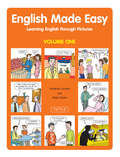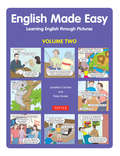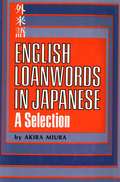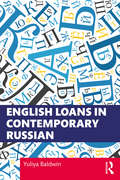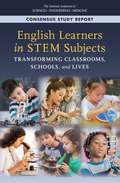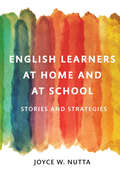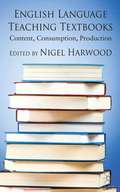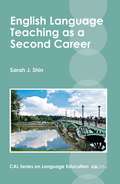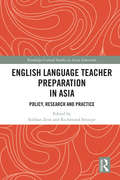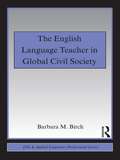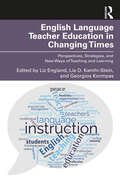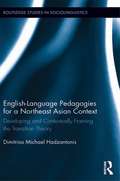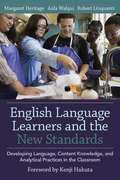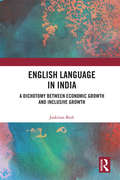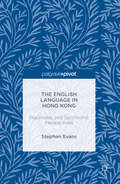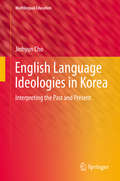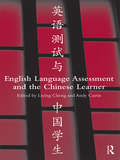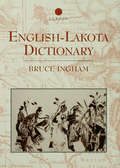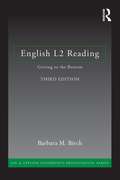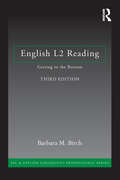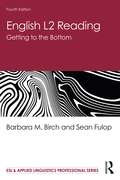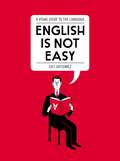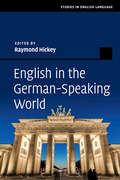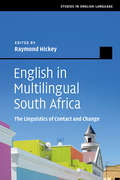- Table View
- List View
English Made Easy Volume One
by Jonathan Crichton Pieter KosterThis is a fun and user-friendly way to learn English English Made Easy is a breakthrough in English language learning-imaginatively exploiting how pictures and text can work together to create understanding and help learners learn more productively. It gives learners easy access to the vocabulary, grammar and functions of English as it is actually used in a comprehensive range of social situations. Self-guided students and classroom learners alike will be delighted by the way they are helped to progress easily from one unit to the next, using a combination of pictures and text to discover for themselves how English works. The pictorial method used in this book is based on a thorough understanding of language structure and how language is successfully learned.English Made Easy, Volume 1 consists of a total of 20 units arranged in groups of five. The first four units presents language and provide learners the opportunities to practice as they learn. The first page of each unit has a list of all the words and phrases to be learned in that unit, together with pronunciation guide. At the end of each unit, an interesting story which uses the language that has just been learned is presented
English Made Easy Volume 2
by Pieter Koster Jonathan CrichtonThis is a fun and user-friendly way to learn EnglishEnglish Made Easy is a breakthrough in English language learning-imaginatively exploiting how pictures and text can work together to create understanding and help learners learn more productively. It gives learners easy access to the vocabulary, grammar and functions of English as it is actually used in a comprehensive range of social situations. Self-guided students and classroom learners alike will be delighted by the way they are helped to progress easily from one unit to the next, using a combination of pictures and text to discover for themselves how English works. The pictorial method used in this book is based on a thorough understanding of language structure and how language is successfully learned.English Made Easy, Volume 2 consists of a total of 20 units arranged in groups of five. The first four units presents language and provide learners the opportunities to practice as they learn. The first page of each unit has a list of all the words and phrases to be learned in that unit, together with pronunciation guide. At the end of each unit, an interesting story which uses the language that has just been learned is presented
English Loanwords in Japanese
by Akira MiuraToriningu-pantsu are not training pants for babies who have not yet been toilet-trained. Toreningu-pantsu are sweat pants. When you jump into a swimming pool you will get wet, but not necessarily uetto. Volleyball, which was invented in the United States, is known as bareboru in Japan, but the tennis volley was the English gentleman's pride before it was America's . A tennis volley is therefore pronounced in British style, bore, not as American bare. Oru means "all" but has a more limited usage. Bosu is often used more negatively than English boss.Many people imagine that speakers of English who study the Japanese language find their way eased by the profusion of "English words" the Japanese have borrowed. Students of the language, however, often complain that borrowed words are more problematic than the older terms in the Japanese word pool.One of the biggest problems is the lack of adequate reference materials on the terms. Many of the existing works do little more than define the terms. This book handles the problematic areas. Here a reader will find sample sentences, tips on usage, and warnings against easy-to-commit mistakes. There are fascinating studies of how certain "English" terms were coined in Japan and of what led the Japanese to redefine certain common English words. Miura examines how certain words entered Japanese, and why they became popular.He theorizes on why an unexpected pronunciation developed. In discussing the borrowed terms, the author draws on many linguistic scholars, discusses prevailing beliefs on etymology and pronunciation, and uses his own considerable experience with both English and Japanese to help the student gain control of some of the most problematic words borrowed by J apanese from English . Each of the 850 words discussed under the text's more than 350 main headings is included in a n index for quick reference. The detail and currency of the explanations contained in this book are unmatched by other books on the subject. For the student hard put to use these borrowed words, this text offers real help.
English Loans in Contemporary Russian
by Yuliya BaldwinEnglish Loans in Contemporary Russian presents over 2,000 English borrowings in the Russian lexicon, providing a unique account of changes in the language and culture. The entries in this practical Russian-English dictionary cover a wide range of well-established loanwords to more recent neologisms. They address an increasingly relevant part of the contemporary Russian lexicon, particularly in the language of business, politics, mass media, computer, medicine, and other professional areas. The dictionary reflects how the language is responding to new patterns of life and will be of interest to Russian language learners and linguists.
English Learners in STEM Subjects: Transforming Classrooms, Schools, And Lives
by National Academies of Sciences Engineering MedicineThe imperative that all students, including English learners (ELs), achieve high academic standards and have opportunities to participate in science, technology, engineering, and mathematics (STEM) learning has become even more urgent and complex given shifts in science and mathematics standards. As a group, these students are underrepresented in STEM fields in college and in the workforce at a time when the demand for workers and professionals in STEM fields is unmet and increasing. However, English learners bring a wealth of resources to STEM learning, including knowledge and interest in STEM-related content that is born out of their experiences in their homes and communities, home languages, variation in discourse practices, and, in some cases, experiences with schooling in other countries. English Learners in STEM Subjects: Transforming Classrooms, Schools, and Lives examines the research on ELs’ learning, teaching, and assessment in STEM subjects and provides guidance on how to improve learning outcomes in STEM for these students. This report considers the complex social and academic use of language delineated in the new mathematics and science standards, the diversity of the population of ELs, and the integration of English as a second language instruction with core instructional programs in STEM.
English Learners in STEM Subjects: Transforming Classrooms, Schools, And Lives
by National Academies of Sciences Engineering MedicineThe imperative that all students, including English learners (ELs), achieve high academic standards and have opportunities to participate in science, technology, engineering, and mathematics (STEM) learning has become even more urgent and complex given shifts in science and mathematics standards. As a group, these students are underrepresented in STEM fields in college and in the workforce at a time when the demand for workers and professionals in STEM fields is unmet and increasing. However, English learners bring a wealth of resources to STEM learning, including knowledge and interest in STEM-related content that is born out of their experiences in their homes and communities, home languages, variation in discourse practices, and, in some cases, experiences with schooling in other countries. English Learners in STEM Subjects: Transforming Classrooms, Schools, and Lives examines the research on ELs’ learning, teaching, and assessment in STEM subjects and provides guidance on how to improve learning outcomes in STEM for these students. This report considers the complex social and academic use of language delineated in the new mathematics and science standards, the diversity of the population of ELs, and the integration of English as a second language instruction with core instructional programs in STEM.
English Learners at Home and at School: Stories and Strategies
by Joyce W. NuttaThe engaging profiles of English Learners at Home and at School offer access to a deeper and broader understanding of the lived experiences of English learners and their families. Such knowledge is essential for all educators in order to anticipate the needs of, and best support, English learners.In this highly readable volume, Joyce W. Nutta helps to build the bridge of knowledge and empathy between teachers and the English learners they support. In an inspired approach to the topic, she presents six compelling portraits of English learners who come from different cultural backgrounds and who are at different points in their educational journeys, from preschool to community college. Informed by real-life observations, extensive interviews, and academic research, these lively portrayals highlight issues and concerns that commonly arise in multicultural and multilingual learning and teaching.Nutta accompanies each profile with details on the specific cultural, linguistic, and educational factors at play and offers sound practical guidance for supporting English learner achievement in classrooms. She suggests educational strategies, including establishing dual-language classrooms, adapting instruction, and inviting parent participation, that can scaffold English learners&’ academic success.English Learners at Home and at School will help educators develop a better awareness of all their students—even those who come from backgrounds vastly different from their own.
English Language Teaching Textbooks
by Nigel HarwoodEnglish language teaching textbooks (or coursebooks) play a central role in the life of a classroom. This edited volume contains research-informed chapters focusing on: analysis of textbook content; how textbooks are used in the classroom; and textbook writers' accounts of the materials writing, design, and publishing process.
English Language Teaching as a Second Career
by Sarah J. ShinThis book explores the experiences of men and women who train to teach ESL as a second career. Drawing from in-depth interviews and observations of 30 students (aged 45 to 73) in a TESOL graduate program, this book provides portraits of these individuals as they develop as teachers. It describes the processes they go through to launch their teaching careers, the successes and challenges they face, and the evolving significance of their work in their overall life goals and achievements. A welcome addition to the growing literature on teacher development, this book will be an important resource for teacher trainers and anyone working in TESOL.
English Language Teacher Preparation in Asia: Policy, Research and Practice (Routledge Critical Studies in Asian Education)
by Subhan Zein Richmond StroupeBringing together a comprehensive range of extended research-based chapters, English Language Teacher Preparation in Asia provides comprehensive insight into policy, research, and practical aspects of teacher preparation for English teachers at pre-service level across multiple contexts in Asia. Written by local and international scholars specialising in TESOL Teacher education, and acknowledging the increasingly complex demands made on teachers of English in view of globalisation, the book explores the multiple factors which are key to effective professional learning. Chapters consider how pre-service teachers are best prepared for the diverse contexts in which English is learnt and taught in settings throughout Asia and draw on in-depth research studies to provide rich, fully contextualised coverage of aspects of teacher preparation including curriculum design, programme development, policy, professional learning communities, assessment education, and teaching practicum. A timely contribution to the field of teacher preparation, this text will be an invaluable resource for teacher educators, pre-service teachers and academics involved in the preparation of English teachers in Asia.
The English Language Teacher in Global Civil Society (ESL & Applied Linguistics Professional Series)
by Barbara M. BirchHow can English language teachers contribute to peace locally and globally? English language teachers and learners are located in the global civil society – an international network of civil organizations and NGOs related to human rights, the environment, and sustainable peace. English, with its special role as an international language, is a major tool for communication within this network. On the local level, many teachers are interested in promoting reconciliation and sustainable peace, but often do not know how to do so. This book provides information, analysis, and techniques to help teachers around the world take action toward this goal. Balancing, in a readable and accessible way, the global and the local, core and periphery, cultural diffusion and resistance, theory and practice, pessimism and optimism, outsider and insider perspectives, the expert role and the apprentice role, and prescriptive and elicitive methods, it offers an alternative to literature about critical applied linguistics, globalization, and peace education that is simply too complex and wordy to spread easily from theoretician to the classroom teacher. The English Teacher in Global Civil Society: synthesizes threads from many fields and topics into a coherent and empowering argument for the activist role English language teachers can take to promote social change draws on humanistic education, peace education, cross-cultural understanding, problem-posing, cooperative learning, and critical thinking methodologies to help English language teachers learn how to teach conflict resolution skills in their classrooms covers issues in critical applied linguistics, approaches and methodologies in ESL/EFL, global and local curricular issues, and specific skill areas such reading, writing, and speaking suggests a new goal for English language teachers: global citizenship. This engaging, informative, provocative, and highly readable book is a welcome resource for English language teacher trainers, pre-service teachers, practicing classroom teachers, and Peace Corps workers around the world.
English Language Teacher Education in Changing Times: Perspectives, Strategies, and New Ways of Teaching and Learning
by Liz England Lía D. Kamhi-Stein Georgios KormpasThis volume addresses challenges that the field of English language teacher education has faced in the past several years. The global pandemic has caused extreme stress and has also served as a catalyst for new ways of teaching, learning, and leading. Educators have relied on their creativity and resiliency to identify new and innovative teaching practices and insights that inform the profession going forward. Contributors describe how teacher educators have responded to the specific needs and difficulties of educating teachers and teaching second language learners in challenging circumstances around the world and how these innovations can transform education going forward into the future. Paving the way for a revitalized profession, this book is essential reading for the current and future generations of TESOL scholars, graduate students, and professors.
English Language Pedagogies for a Northeast Asian Context: Developing and Contextually Framing the Transition Theory (Routledge Studies in Sociolinguistics)
by Michael HadzantonisThis book investigates, from a sociocultural, linguistic, and pedagogical perspective, the conceptual and pragmatic frameworks that characterize secondary language learning in a Northeast Asian context. Hadzantonis contextualizes these salient domains through an engagement with social and cultural themes such as the familial, political, as well as cultural commodities and socioeducational structures. In this way, the text employs tools such as transnational theory and performativity and develops a model that contributes to the resolution of one of the greatest economic issues of the time, that of ineffective secondary language learning.
English Language Learners and the New Standards: Developing Language, Content Knowledge, and Analytical Practices in the Classroom
by Margaret Heritage Aída Walqui Robert LinquantiIn English Language Learners and the New Standards, three leading scholars present a clear vision and practical suggestions for helping teachers engage ELL students in simultaneously learning subject-area content, analytical practices, and language. This process requires three important shifts in our perspective on language and language learning—from an individual activity to a socially engaged activity; from a linear process aimed at correctness and fluency, to a developmental process, focused on comprehension and communication; and from a separate area of instruction to an approach that embeds language development in subject-area activities. In English Language Learners and the New Standards, the authors:Clarify the skills and knowledge teachers need to integrate content knowledge and language developmentShow how teachers can integrate formative assessment in ongoing teaching and learningDiscuss key leverage points and stress points in using interim and summative assessments with ELLsProvide classroom vignettes illustrating key practicesFinally, the authors explain the theories and research that underlie their vision and examine the role of policy in shaping pedagogy and assessment for ELL students.
English Language in India: A Dichotomy between Economic Growth and Inclusive Growth
by Jaskiran BediThis book examines the relationship between the English language and growth – economic and inclusive – in India. It explores why English continues to be the language of aspiration long after Independence. With the second largest English-speaking population in the world today, India is testimonial to how a linguistic legacy continues to cast a long shadow on its contemporary discourse in the economic arena. The volume: Explores how English language proficiency constitutes as human capital. Draws in the latest India Human Development Survey data. Investigates the relationship between the language and economic indicators such as wages, household income and state growth. Purther investigates the role of English language in the inclusivity of growth. Provides a snapshot of the pedagogy of English in the Indian education system. First of its kind in scope, this volume will be of great interest to scholars of economics, education, sociolinguistics, development studies, politics and sociology. It will also be of great interest to the general reader.
The English Language in Hong Kong
by Stephen EvansThis book presents an empirically-grounded sociolinguistic history of the English language in Hong Kong in the past 170 years. Using substantial sets of diachronic and synchronic data, it traces the changing status and functions of English in relation to spoken Cantonese, Mandarin and written Chinese in the key domains of government, education and business. The author tracks the rise of English-knowing bilingualism in the city's Chinese community and explores the evolutionary dynamics of Hong Kong English. He also speculates on the future of English in the territory, particularly after 2047 when the 'one country, two systems' framework established by the Sino-British Joint Declaration is dismantled. Researchers and students working in the fields of sociolinguistics, English as a global language, world Englishes, applied linguistics and English-language education will find this book provides valuable information and insights about the uses and users of English in colonial and post-colonial Hong Kong. More generally, it makes a unique contribution to the literature on the diffusion and diversification of English worldwide.
English Language Ideologies in Korea
by Jinhyun ChoThis volume critically examines the phenomenon of "English fever" in South Korea from both micro- and macro-perspectives. Drawing on original research and rich illustrative examples, the book investigates two key questions: why is English so popular in Korea, and why is there such a gap between the 'dreams' and 'realities' associated with English in Korea? These questions are explored through the eyes of English-Korean translators and interpreters, who represent the professional group most intensely engaged in the zeal for English language mastery. Macro-perspectives focus on historical factors leading to the rise of English, with English-Korean translation and interpreting as a key theme. Micro-perspectives explore the dreams that individuals attach to English and the ways in which they imagine it can transform their lives, and contrast these dreams with the stark realities felt on the ground. The gaps between these dreams and realities are explored from various angles, which include commodification, gender and neoliberalism. The book thus offers fresh insights on how the phenomenon of "English fever" has been created, reproduced, and sustained from both historical and contemporary viewpoints.
English Language Assessment and the Chinese Learner
by Liying Cheng Andy Curtis'This volume addresses a very timely and important topic, and provides both broad and in-depth coverage of a number of large-scale English tests in China, including Hong Kong and Taiwan, and about the Chinese learner.' – Lyle F. Bachman, From the Foreword Building on current theoretical and practical frameworks for English language assessment and testing, this book presents a comprehensive, up-to-date, relevant picture of English language assessment for students in China (Mainland China, Hong Kong and Taiwan) and for Chinese learners of English around the world. Written by well-recognized international scholars in language testing, it covers: the history of tests and testing systems, issues and challenges, and current research in China both test-designers’ and test-users’ points of view on test development and test validation within a range of political, economical, social, and financial contexts in China theoretical/conceptual perspectives on the use of the English language assessment at different levels, including societal, university, and schools empirical research related specifically to test development, curricular innovation, and test validation Given the long history of objective testing and its extensive use in Chinese society, and considering the sheer number of students taking various tests in English in China and elsewhere, an understanding of the impact of English language testing is essential for anyone involved in testing and assessment issues in China and elsewhere in the world. This is a must-read volume for testing and assessment policy makers, curriculum designers, researchers, ESL/EFL materials writers, graduate students, and English language teachers/researchers at all levels.
English-Lakota Dictionary
by Bruce InghamThis dictionary of 12,000 entries aims to preserve Indian culture and at all points illustrate the use of words in examples, especially syntactic words, whose usage cannot be captured purely by giving an English equivalent. It provides depth as regards the usage of frequently occurring items and especially in the use of syntactic elements and usage in context.
English L2 Reading: Getting To The Bottom
by Barbara M. BirchEnglish L2 Reading, Third Edition offers teachers research-based insights into bottom-up skills in reading English as a second language and a solid foundation on which to build reading instruction. Core linguistic and psycholinguistic concepts are presented within the context of their application to teaching. The goal is to balance or supplement (not replace) top-down approaches and methodologies with effective low-level options for teaching English reading. The text's pedagogical features-- Questions, Study Guide Questions. Discussion Questions, Spotlight on Teaching sections-- engage readers of the text in moving easily from linguistic details and psycholinguistic data and theory to practical explanations and suggestions for teaching. Two Appendices provide tables that list the graphemes or the phonemes of English.
English L2 Reading: Getting to the Bottom
by Barbara M. BirchEnglish L2 Reading, Third Edition offers teachers research-based insights into bottom-up skills in reading English as a second language and a solid foundation on which to build reading instruction. Core linguistic and psycholinguistic concepts are presented within the context of their application to teaching. The goal is to balance or supplement (not replace) top-down approaches and methodologies with effective low-level options for teaching English reading. The text’s pedagogical features— Questions, Study Guide Questions. Discussion Questions, Spotlight on Teaching sections— engage readers of the text in moving easily from linguistic details and psycholinguistic data and theory to practical explanations and suggestions for teaching. Two Appendices provide tables that list the graphemes or the phonemes of English. Changes in the Third Edition Shift in focus from criticism of whole language methodologies to a more neutral stance —times have changed and the study of lower-level reading strategies is now mainstream Greater focus on linguistic form, along with function and meaning Updated information about reading strategies at each level of the reading process More Spotlight on Teaching sections, one for each chapter New chapter on spelling development
English L2 Reading: Getting to the Bottom (ESL & Applied Linguistics Professional Series)
by Barbara M. Birch Sean FulopEnglish L2 Reading: Getting to the Bottom uses research-based insights to examine bottom-up skills in reading English as a second language. This fourth edition clearly presents core concepts alongside their practical applications to teaching contexts, with updated research findings, a new focus on metalinguistic awareness, and new resources for students. The text’s pedagogical features help readers connect linguistic details and psycholinguistic theory with practical explanations and teaching suggestions. Pre-reading Questions challenge readers to analyze their own experiences. Study Guide Questions allow readers to review, discuss, and assess their knowledge. Discussion Questions elaborate on themes in each chapter, while the new Language Awareness Activities help develop metalinguistic awareness. Three Appendices provide tables that list the graphemes and the phonemes of English, as well as a brand-new dictionary pronunciation guide. New to the fourth edition: Substantially revised and updated research on linguistics New, evidence-based models on the reading process Language Awareness Activities that highlight metalinguistic awareness Word study examples in each chapter For teachers, teacher trainers, reading researchers, or anyone interested in teaching reading, this popular, comprehensive, myth-debunking text provides clear and practical guidance towards effectively supplementing top-down teaching approaches with bottom-up reading strategies.
English Is Not Easy: A Visual Guide to the Language
by Luci GutiérrezA cheeky, sophisticated, and strikingly illustrated guide that leaves generic English reference books in the dust When prominent Barcelona-based illustrator Luci Gutiérrez found herself tuning out in English class, she used her love of drawing to help retain what she’d learned. Ditching the kind of bland and useless phrases that fill most English textbooks, Gutiérrez uses whimsical characters, cheeky dialogue, and even insults to bring vocabulary, grammar, and usage topics to life. Nearly forty-seven million people in the United States speak a language other than English at home, and even most native speakers struggle with subtle distinctions, such as when to use “whether” as opposed to “if.” (For example: I wonder whether I should have added a little more poison to his tea.) Already published to wide acclaim abroad, English Is Not Easy is sure to delight grammar mavens and students of English in America.
English in the German-Speaking World (Studies in English Language)
by Raymond HickeyEnglish has a considerable history in Germany, Austria and Switzerland, and present-day English has a significant influence on the vocabulary of modern German. Examining the ongoing influence of English on German in these countries, Raymond Hickey leads a team of authors to explore a wide range of topics, such as the history of English teaching in Germany, the type of English spoken in German-speaking countries today, and the role of English in German society. Borrowings from English in present-day German, as well as the use of English in public places, is also discussed, as is the use of English by non-Germans living in Germany, and the situation of Germany as a country with English as a foreign language. Comparisons with other European countries are also analysed, and a consideration of the German-English interface in places as far apart as the United States and Namibia, is also presented.
English in Multilingual South Africa: The Linguistics of Contact and Change (Studies in English Language)
by Raymond HickeySouth Africa is a country characterised by great linguistic diversity. Large indigenous languages, such as isiZulu and isiXhosa, are spoken by many millions of people, as well as the languages with European roots, such as Afrikaans and English, which are spoken by several millions and used by many more in daily life. This situation provides a plethora of contact scenarios, all of which have resulted in language variation and change, and which forms the main focus of this insightful volume. Written by a team of leading scholars, it investigates a range of sociolinguistic factors and the challenges that South Africans face as a result of multilingualism and globalisation in both education and social interaction. The historical background to English in South Africa provides a framework within which the interfaces with other languages spoken in the country are scrutinised, whilst highlighting processes of contact, bilingualism, code-switching and language shift.
